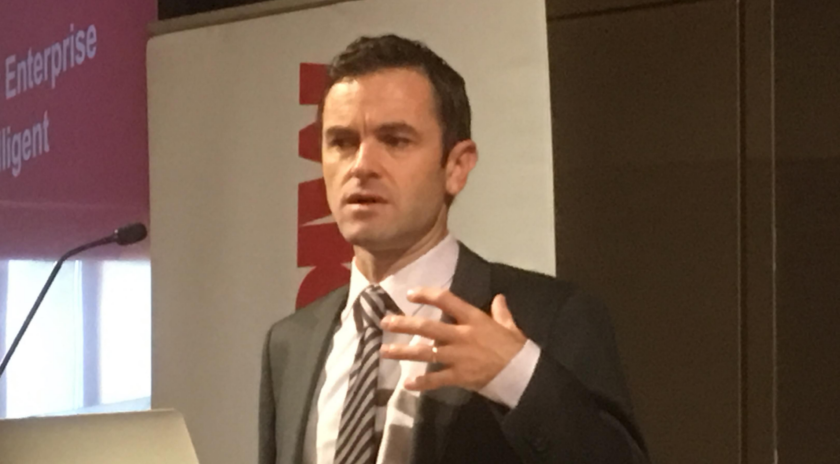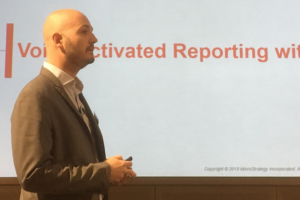HITS

AI Opportunities, Challenges Take Center Stage at MicroStrategy Symposium
Story Highlights
NEW YORK – Artificial intelligence (AI) can play an important role in organizations successfully transforming into intelligent enterprises, but it can’t be relied on to cure all of a company’s problems, according to MicroStrategy and Boris Evelson, Forrester Research VP and principal analyst.
Providing one example of how MicroStrategy is helping its customers via AI, Hugh Owen, its SVP of product marketing, said Oct. 25 that as part of a recently added enhancement included in Version 11 of the MicroStrategy Intelligence Enterprise Platform, “you can now, with our data discovery product, type a Google-like search into our interface and we have an AI-powered engine that will take what you’re typing with text and actually start building the analytics for you.”
MicroStrategy’s new AI-powered content recommendations capability enables users to search for answers in the platform’s library and see personalized recommendations for other documents and dossiers, he pointed out.
Owen’s comments were made during the first keynote presentation, “The Future Belongs to the Intelligent Enterprise,” at the MicroStrategy Symposium, held at Convene’s downtown Manhattan event venue in the Financial District.
AI can significantly help companies transform into insights-driven businesses, Forrester’s Evelson went on to point out in the next keynote presentation, “Systems of Insight: Next-generation Business Intelligence.” And it’s crucial for enterprises today to transform from merely data-driven organizations to insights-driven ones, he said, reiterating comments he made Aug. 21 during the webinar “Transformation with Data: The Journey to the Intelligent Enterprise.”
At the MicroStrategy Symposium, he again pointed to data showing insights-driven companies were growing at an average of more than 30% annually and were on track to take $1.8 trillion away from their non-insights-driven rivals by 2021. Over the next few years, such companies will be growing 8-10 times faster than their non-insights-driven rivals, he again projected, adding: “You want to be on the winning side of the picture.”
 It’s, therefore, important for companies to invest in AI-enhanced BI platforms, automation-focused machine learning (ML), deep learning frameworks, natural language understanding (NLU) and service provider AI platforms – all of which stand to provide them with high business value, he said.
It’s, therefore, important for companies to invest in AI-enhanced BI platforms, automation-focused machine learning (ML), deep learning frameworks, natural language understanding (NLU) and service provider AI platforms – all of which stand to provide them with high business value, he said.
Over the next decade, while AI won’t replace BI, BI tools that use AI will replace those that don’t, he predicted.
Advantages that AI-enabled BI has over earlier-generation BI include the fact that while old BI uses manual coding and data warehouses, AI-enabled BI is based on ML and involves largely automated data discovery and semantic data lakes, he said. The user interface is also superior with AI-enabled BI, consisting of natural language processing (NLP) and natural language generation (NLG) compared to the old BI’s point-and-click, drag-and-drop visual querying, he noted. While older BI is derived mostly from structured data, AI-enabled BI is derived from all data – whether it’s structured or unstructured, he said.
The older BI also features “knowledge gaps” because they don’t address the concept of “I don’t know what I don’t know,” he said. AI-enabled BI, on the other hand, uses ML and cooperative usage to suggest popular reports, dashboards and areas of interest to explore, he pointed out.
Some organizations, however, may have somewhat inaccurate expectations for what AI can alone do for them, he told MicroStrategy Symposium attendees. “You can’t believe how many” times clients ask if they can’t just entirely replace their current business intelligence (BI) systems with AI – and the clear answer is no, he told attendees.
It’s also not so easy – or inexpensive — for companies to start using AI, he conceded. AI technologies are also “not a panacea” for organizations, he stressed.
In another session at the Symposium, “Alexa, Bots, and Natural Language: Building analytics applications that talk to you,” MicroStrategy sales engineer Antoine Issaly discussed how AI, augmented reality, virtual reality and the Internet of Things (IoT) are converging into smart apps that can drive enormous value for consumers and enterprises.
 Application program interfaces (APIs) can bring AI and conversational BI into an organization’s environment and scale to meet enterprise demands, according to MicroStrategy.
Application program interfaces (APIs) can bring AI and conversational BI into an organization’s environment and scale to meet enterprise demands, according to MicroStrategy.
Issaly also explained how MicroStrategy can help its customers build AI-supported apps to boost adoption and gave an overview of the MicroStrategy software development kit capabilities that make it possible to integrate with Amazon’s popular Alexa voice-controlled virtual assistant.
Although AI concepts were developed many years ago, he said it’s taken so long for AI technologies to become applicable for companies today because we were missing the three main AI ingredients in the past. He explained: “We did not have the algorithms. We did not have the data and the computing power” that has now multiplied thanks to all the cloud computing technologies that have become so pervasive.
Calling chatbots “dumb,” he told attendees that the AI-driven “SmartBots” developed by it and partner INNAAS with the Ask2data platform are far superior. For one thing, Ask2data is self-service, enabling business users to easily access information with no training or software deployment and across communication channels already in place at an organization, such as through corporate chat, he noted.
All the customer has to do is “plug into what INAAS created and you’re up and running” with a SmartBot “in a matter of days,” he said. All the heavy lifting is fully automated by the Ask2data platform, according to Issaly, who asked attendees to let MicroStrategy know if they had any recommendations for what capabilities can be added to the platform’s SmartBots to make the platform even better.









